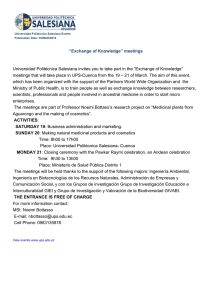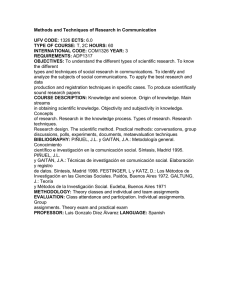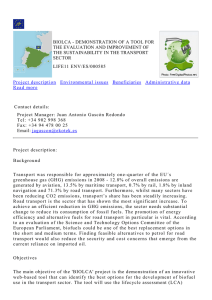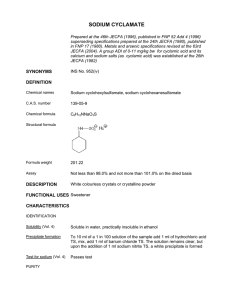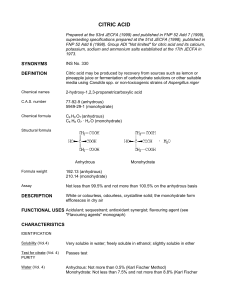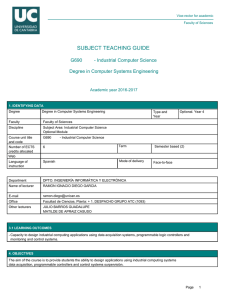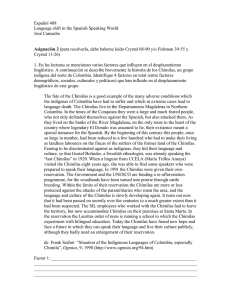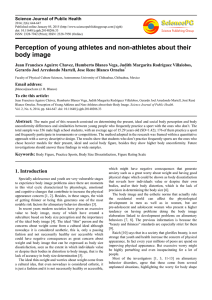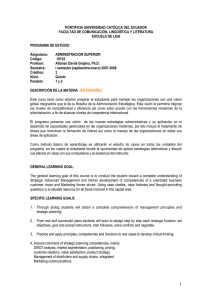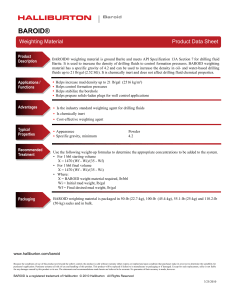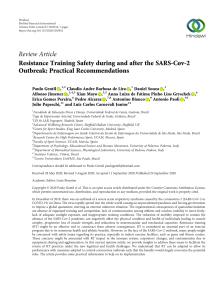Incident factors in facility location: An application in the Colombian
Anuncio
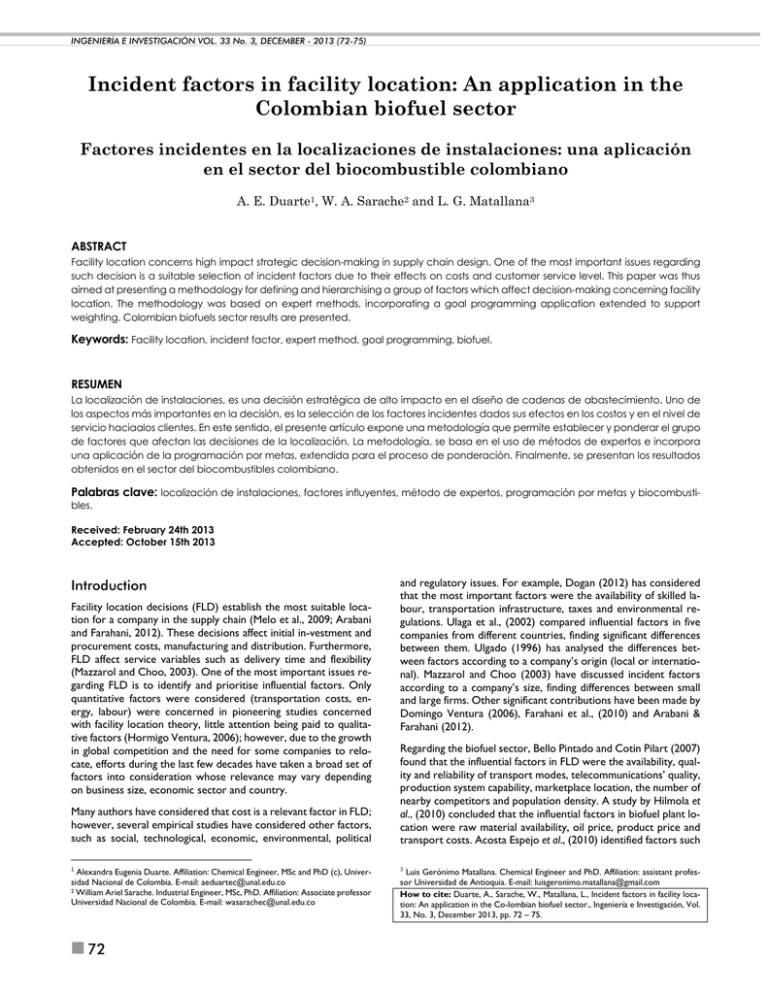
INGENIERÍA E INVESTIGACIÓN VOL. 33 No. 3, DECEMBER - 2013 (72-75) Incident factors in facility location: An application in the Colombian biofuel sector Factores incidentes en la localizaciones de instalaciones: una aplicación en el sector del biocombustible colombiano A. E. Duarte1, W. A. Sarache2 and L. G. Matallana3 ABSTRACT Facility location concerns high impact strategic decision-making in supply chain design. One of the most important issues regarding such decision is a suitable selection of incident factors due to their effects on costs and customer service level. This paper was thus aimed at presenting a methodology for defining and hierarchising a group of factors which affect decision-making concerning facility location. The methodology was based on expert methods, incorporating a goal programming application extended to support weighting. Colombian biofuels sector results are presented. Keywords: Facility location, incident factor, expert method, goal programming, biofuel. RESUMEN La localización de instalaciones, es una decisión estratégica de alto impacto en el diseño de cadenas de abastecimiento. Uno de los aspectos más importantes en la decisión, es la selección de los factores incidentes dados sus efectos en los costos y en el nivel de servicio haciaalos clientes. En este sentido, el presente artículo expone una metodología que permite establecer y ponderar el grupo de factores que afectan las decisiones de la localización. La metodología, se basa en el uso de métodos de expertos e incorpora una aplicación de la programación por metas, extendida para el proceso de ponderación. Finalmente, se presentan los resultados obtenidos en el sector del biocombustibles colombiano. Palabras clave: localización de instalaciones, factores influyentes, método de expertos, programación por metas y biocombustibles. Received: February 24th 2013 Accepted: October 15th 2013 Introduction12 3 Facility location decisions (FLD) establish the most suitable location for a company in the supply chain (Melo et al., 2009; Arabani and Farahani, 2012). These decisions affect initial in-vestment and procurement costs, manufacturing and distribution. Furthermore, FLD affect service variables such as delivery time and flexibility (Mazzarol and Choo, 2003). One of the most important issues regarding FLD is to identify and prioritise influential factors. Only quantitative factors were considered (transportation costs, energy, labour) were concerned in pioneering studies concerned with facility location theory, little attention being paid to qualitative factors (Hormigo Ventura, 2006); however, due to the growth in global competition and the need for some companies to relocate, efforts during the last few decades have taken a broad set of factors into consideration whose relevance may vary depending on business size, economic sector and country. Many authors have considered that cost is a relevant factor in FLD; however, several empirical studies have considered other factors, such as social, technological, economic, environmental, political 1 Alexandra Eugenia Duarte. Affiliation: Chemical Engineer, MSc and PhD (c), Universidad Nacional de Colombia. E-mail: [email protected] 2 William Ariel Sarache. Industrial Engineer, MSc, PhD. Affiliation: Associate professor Universidad Nacional de Colombia. E-mail: [email protected] 72 and regulatory issues. For example, Dogan (2012) has considered that the most important factors were the availability of skilled labour, transportation infrastructure, taxes and environmental regulations. Ulaga et al., (2002) compared influential factors in five companies from different countries, finding significant differences between them. Ulgado (1996) has analysed the differences between factors according to a company’s origin (local or international). Mazzarol and Choo (2003) have discussed incident factors according to a company’s size, finding differences between small and large firms. Other significant contributions have been made by Domingo Ventura (2006), Farahani et al., (2010) and Arabani & Farahani (2012). Regarding the biofuel sector, Bello Pintado and Cotin Pilart (2007) found that the influential factors in FLD were the availability, quality and reliability of transport modes, telecommunications’ quality, production system capability, marketplace location, the number of nearby competitors and population density. A study by Hilmola et al., (2010) concluded that the influential factors in biofuel plant location were raw material availability, oil price, product price and transport costs. Acosta Espejo et al., (2010) identified factors such 3 Luis Gerónimo Matallana. Chemical Engineer and PhD. Affiliation: assistant professor Universidad de Antioquia. E-mail: [email protected] How to cite: Duarte, A., Sarache, W., Matallana, L., Incident factors in facility location: An application in the Co-lombian biofuel sector., Ingeniería e Investigación, Vol. 33, No. 3, December 2013, pp. 72 – 75. DUARTE, SARACHE AND MATALLANA as cost, labour availability, technology availability and infrastructure. Other studies by Bennedetti Santos and Rathmann (2009) and Rentizelas and Tatisiopoulos (2010) provided important findings concerning the field of biofuel plant facility location factors. Few contributions about this topic have been made regarding Colombia. The Conpes report 3547 (2008) revealed some critical factors to be considered in biofuel chain design, such as transport and communication infrastructure, red tape and institutional weakness. Gualteros Sanchez (2011) identified a critical group of factors by comparing several national research centre reports with those of their international peers; although this study found several quantitative factors, it only addressed a few qualitative factors and could not identify a specific set of factors matched with all the particularities of the national context for specific biofuel projects. This paper was thus aimed at showing the results of a Colombian biofuel sector study to establish a set of relevant factors to be considered in FLD related to this kind of company; the article ranked factors to identify the most relevant ones. A combination of expert methods and goal programming techniques were used, identifying the three most important factors for this sector as being transport infrastructure quality, the region’s agricultural capacity and utility quality and reliability. Methodology Two main issues must be addressed when studying factors affecting FLD for a particular industrial sector: identifying all influential factors and defining their relative importance. The proposed methodology consisted of 5 stages: the preliminary selection of factors, selecting experts, the final selection of factors, hierarchising factors and calculating the level of agreement between experts. Stage 1. A preliminary selection of factors. Based on earlier contributions, especially those related to the biofuel industry, a preliminary list of potential factors possibility affecting FLD had to be prepared. Some experts had the chance to examine the list to improve it. Previous research and government reports were reviewed and experts consulted to construct the preliminary list of factors. Stage 2. Selecting experts. Expert methods are geared towards making precise questions (excluding double interpretation) aimed at obtaining answers which can be quantified and processed through qualitative methods (Lissabet Rivero, 1998). An expert is a person who can provide an objective opinion about an issue based on his/her knowledge and previous experience (Ramirez Urizarri and Toledo Fernandez, 2005). The number of experts depends on the aim of analysis and group homogeneity; according to Ziglio (1996), a small group of 10 to 15 experts is usually enough to achieve reliable results. Stage 3. Final selection of factors. At this stage, experts should independently review the preliminary list of factors, eliminating those deemed not relevant. They also included new factors if necessary. The process was repeated in several successive rounds; the list of factors was rebuilt in each round until reaching final agreement (Ziglio, 1996). Stage 4. Hierarchising factors. Factors were ranked; each expert ranked the list of factors according to their relevance. Factors were then weighted based on the experts’ previous ranking. Goal programming (GP) was posed in this methodology; GP is a branch of multi-objective optimisation, in turn being a branch of multi-criteria decision analysis or multiple-criteria decision-making. This is an extension of linear programming for handling multiple, normally-conflicting objective measures (Jones and Tamiz, 2010). GP includes three types of variant: weighted GP, MinMax GP and extended GP. Extended GP was introduced as it provides a compromise solution between weighted GP and MinMax GP (Barichard et al., 2009). GP enabled weighting (Wi) each factor i taking into account the level of importance given by the experts (j). The objective function (equation 1) in the mathematical model minimised the weighted sum of positive and negative deviations for weighting each factor and maximum deviation (D), using a compromise equation varying fluctuation factor λ. The objective function was subject to the set of constraints represented in equations 2, 3, 4, 5 and 6. Equation 2 established that the sum of the expected weighting for each factor (Wi) and its positive and negative deviation had to be equal to the rating given by expert j. Equation 3 established that the sum of positive and negative deviations multiplied by the fluc tuation factor (1 λ had to be less than the máximum deviation (D) of all possible deviations (Dij). According to equation 4, the sum of positive and negative deviations had to be equal to the máximum deviation in each factor for each expert ( . Equations 5 and 6 suggest that the negative and positive deviations had to have positive values. Objective function: 1 ∗ , , (1) subject to: 1 ∗ 0 0 ∀ 1, … , 1, … , 1, … , 1, … , ; ; ; ; ; (2) (3) (4) (5) (6) 1, … , 1, … , 1, … , 1, … , 1, … , where: : objective function : fluctuation factor (0 1 : maximum deviation to be minimised : maximum deviation to be minimised in each factor for each expert : weighting each factor evaluated : rating factor i given by expert j : positive and negative deviation from values : the amount of experts involved : the number of factors Stage 5. Calculating the level of agreement between experts. The experts’ ranking of factors was evaluated by calculating Kendall′s coefficient of concordance ( ). The value of K established the level of agreement between expert judgments. If 0.5 1, there was a good level of agreement and therefore the hierarchy of factors (weighting) was validated; otherwise, it was necessary to check the corresponding process in stage 3 again (Siegel, 1994). The equations related to this stage were: 12 ∗ INGENIERÍA E INVESTIGACIÓN VOL. 33 No. 3, DECEMBER - 2013 (72-75) (7) 73 INCIDENT FACTORS IN FACILITY LOCATION: AN APPLICATION IN THE CO-LOMBIAN BIOFUEL SECTOR 1, … , 0,5 (8) (9) 1 ∀ ; 1, … , the experts included an additional factor: the region’s safety and criminality given its impact on project risk (Table 3). Table 3. Final list of factors Factors Security and criminality (10) Attitude of local government to the project Quality and reliability of utilities Quality of transport infrastructure where: : the amount of experts : the number of factors : Kendall’s coefficient of concordance : total rating of factor : the mean of total ratings : deviation from the mean value of trials Community attitude towards a specific project Social impact. The region’s agricultural capacity Results and Discussion Stage 1. Preliminary selection of factors. A preliminary list of factors was prepared, based on the state of the art; the list was then reviewed by four experts (two academic and two consultants) having extensive expertise in the biofuel industry. They took two important elements into consideration: the characteristics of an industrial project for biofuel production and the reality of the Colombian context (Table 1). Table 1. Preliminary list of factors Seaport location Government incentives Local government attitude towards a project Quality of raw materials Quality and reliability of utilities Quality of transport infrastructure The first factor ( ) referred to the region’s security and criminality regarding rebel groups’ activities. Security and criminality is an important factor for agribusiness projects in Colombia, due to their rural location. This factor is infrequently mentioned in the pertinent literature and arises from the political and social context. The second factor ( ) was related to the attitude of local government towards local and inward investment. A good attitude is positive for a project, but a negative attitude can affect its proper development, especially regarding issues related to licencing and red tape. The third factor ( ) was related to the quality and reliability of utilities essential for a project, such as water, electricity supply and communications. The fourth factor ( ) addressed issues related to transport infrastructure access and quality (roads, ports and transport modes). The fifth factor ( ) was related to the community’s attitude towards a particular project. The sixth factor ( ) referred to the social benefits that a project might generate for the region’s inhabitants, especially concerning job creation. The seventh factor ( ) took into account the region’s agricultural capacity for supplying the main raw material (biomass). Stage 4. Hierarchising factors. The experts prioritised the factors; the three most important factors were the region’s agricultural capacity ( ), transport infrastructure quality ( ) and quality and reliability of utilities (3), followed by , , and (see Table 4). Community attitude towards a specific project Social impact The region’s quality of life The region’s agricultural capacity Stage 2. Selection of experts. A group of 10 experts was selected for the final list of factors: experts from the academic (3), business (4) consulting services (1) and government sectors (2). Table 2 shows the list of experts, including their professional profile and type of work. Their names have been omitted as part of the research reservation. Table 4. Rating factors (7 = most important) (1 = least important) Table 2. List of experts Area of knowledge Type of work Agriculture government Agroindustry consulting Biofuels academic Agroindustry government Biofuels academic Facility management academic Agroindustry business Agroindustry business Project management business Biofuels business Stage 3. Final selection of factors. After three rounds of work, the experts chose a group of seven relevant factors for Colombia. Four factors were eliminated by the experts from the original list in Table 1 (location of seaports, government incentives, quality of raw materials and the region’s quality of life) because some were not relevant and others were considered redundant. However, 74 4 1 3 6 2 5 7 28 2 6 5 4 1 3 7 28 1 5 2 4 3 6 7 28 4 2 1 6 3 5 7 28 4 1 6 7 5 2 3 28 3 2 4 7 5 1 6 28 2 1 5 6 4 3 7 28 3 1 4 7 5 2 6 28 3 1 5 6 4 2 7 28 2 1 5 7 4 3 6 28 28 21 40 60 36 32 63 280 Table 5. Weighting for factor i obtained from the mathematical model Σ 0-0.1 0.071 0.125 0.125 0.232 0.125 0.125 0.196 1.000 6.250 0.2-1 0.107 0.089 0.125 0.232 0.125 0.125 0.196 1.000 5.250 The rating of factors by experts , together with variables , D, n , p , W , and fluctuation factor ( ), were used as parameters for the mathematical model. A sensitivity analysis was used for the fluctuation factor, varying its value from 0 to 1. GAMS Distribution 23.9.3 (release 2012) software gave the results shown in Table 5. Due to the minimum value for the objective function ( ) INGENIERÍA E INVESTIGACIÓN VOL. 33 No. 3, DECEMBER - 2013 (72-75) DUARTE, SARACHE AND MATALLANA occurring for the 0.2-1 interval, the weighting factors values were chosen. for these Table 6 shows the experts’ maximum deviation values based on the rating for each factor. The opinion of expert 2 ( ) was favoured according to the results for values within the 0-0.1 interval. Expert opinion was favoured in the lower maximum deviation value of the experts’ opinions. All other experts’ opinions were favourable for the 0.2-1 interval. and Practical Applications., Vol. 618, Berlin Heidelberg Springer, 2009. Bello Pintado, A., Contín-Pilart, I., Influencia de los factores de localización en la fijación de los precios de los carburantes de automoción en España., Cuadernos Económicos de ICE, Vol. 1, No. 79, 2010, pp. 45-67. Benedetti Santos, O. I., Rathmann, R., Identification and analysis of local and regional impacts from the introduction of biodiesel production in the state of Piauí., Energy Policy, No. 37, 2009, pp. 40114020. Table 6. Expert evaluation maximum deviations Conpes-3547. Política nacional logística., Bogotá, DNP, DIAN, Min transporte, Min comercio, Industria y Turismo, 2008. 0-0.1 0.089 0.089 0.089 0.089 0.089 0.089 0.089 0.089 0.089 0.089 0.089 Dogan, I., Analysis of facility location model using Bayesian Networks., Expert systems with aplications, Vol. 39, No. 1, 2012, pp. 1092-1104. 0.2-1 0.112 0.054 0.125 0.089 0.089 0.089 0.089 0.054 0.054 0.054 0.054 Table 5 shows that optimal value for objective function (z) was achieved for values of ʎ between 0.2 and 1. Therefore, the final 23.2%; weighting of factors was as follows: 19.6%; 12.5%; 12.5%; 12.5%; 8.9%. 10.7%; Domingo Ventura, J. P., La evolución de los factores de localización de actividades., Reporte de investigación, Cataluña, Universidad Politécnica de Cataluña, 2006, pp. 29-66. Stage 5. Calculating the level of agreement between experts. Equations 5 to 8 gave: 40; 1514; 0.54. Because 0.5, there was a good level of agreement between experts and therefore the factors’ weighting was accepted. Gualteros Sánchez, J. M., Estudio prospectivo de la cadena productiva del Biodiesel a partir de palma africana en Colombia., Tesis de maestría presentada en la Universidad Nacional de Colombia Sede Manizales, 2011. Conclusions Facility location is a high-impact decision affecting costs and customer service. Choosing the right place to set up a company becomes a decision that should be carefully analysed. Several factors which must be considered in FLD have been identified in the state of the art; however, not all of them are relevant in all contexts. A group of relevant factors must be selected for ensuring each particular facility’s correct location. Seven factors were identified for biofuel plant location in Colombia: security and criminality, local government attitude towards a project, quality and reliability of utilities, quality of transport infrastructure, community attitude towards a project and the region’s social impact and agricultural capacity. However, according to the experts’ judgment, the two most important factors were quality of transport infrastructure and the region’s agricultural capacity. Farahani, R. Z., SteadieSeifi, M., Asgari, N., Multiple criteria facility location problems: A survey., Applied Mathematical Modelling, Vol. 34, No. 7, 2010, pp. 1689-1709. Hilmola, O. P., Saranen, J., Padilha, F., Location criteria and strategic factors of biodiesel factory establishment in finnish context., PhD thesis presented at Lappenranta University of Technology, Lappenranta, 2010. Hormigo Ventura, J., La evolución de los factores de localización de actividades., Barcelona, Universitat Politécnica de Catalunya, 2006. Jones, D. F., Tamiz, M., Practical Goal Programming., New York, Springer Books, 2010. Lissabet Rivero, J. L., La utilización del método de evaluación de expertos en la valoración de los resultados de las investigaciones educativas., 1998. En: http://www.ilustrados.com. Consulted on June 25th 2010. Mazzarol, T., Choo, S., A study of the factors influencing the operating location decision of small firms., Property Management, Vol. 21, No. 2, 2003, pp. 190-208. Melo, M. T., Nickel, S., Saldanha-da-Gama, F., Facility location and supply chain management – A review., European Journal of Operational Research, No. 196, 2009, pp. 401–412. Based on the above results and taking into account that biofuel industries are considered a strategic sector for Colombian development, national and local governments must design appropriate policies for improving the country’s performance regarding the identified factors. In particular, there must be more investment in road and port infrastructure and the development of public policy to encourage crop-growing areas as well as improvements in utilities (energy, water and telecommunications) for attracting local and foreign investment. Ramírez Urizarri, A., Toledo Fernández, A. M., Algunas consideraciones acerca del método de evaluación utilizando el criterio de expertos., En: http://www.ilustrados.com/publicaciones /EEkZylEFEVDEhxqKXi.php. Recuperado el 2 de diciembre de 2010. References Ulaga, W., Sharma, A., Krishnan. Plant location and place marketing: understanding the process from the business customer’s perspective., Industrial Marketing Management, No. 31, 2002, pp. 393–401. Acosta-Espejo, L. G., Ortega-Blu, R. A., Muñoz-Lagos, R. E., González-Platteau, R. A., Biocombustibles en chile III. Localización simultánea de centros de acopio y plantas productoras., Agrociencia, Vol. 44, No. 7, 2010, pp. 861-872. Arabani, A. B., Farahani, R. Z., Facility location dynamics: An overview of classification and applications., Computers and Industrial Engineering, Vol. 62, No. 1, 2012, pp. 408-420. Barichard, V., Ehrgott, M., Gandibleux, X., T'Kindt, V., Multiobjective Programming and Goal Programming Theoretical Results Rentizelas, A. A., Tatsiopoulos, I. P., Locating a bioenergy facility using a hybrid optimization method. International Journal of Production Economics, Vol. 123, No. 1, 2010, pp. 196-209. Siegel, S. Estadística no paramétrica aplicada a las ciencias de la conducta, Editorial Trillas, México, D.F., 1994. Ulgado, F. M., Location Characteristics of Manufacturing Investments in the US: A comparison of American an foreing-based firms. Management International Review, Vol. 36, No. 1, 1996, pp. 7-26. Ziglio, E., The Delphi method and its contribution to decision-making. In: M. Alder, E. Ziglio (Eds.), Gazing into the Oracle: The Delphi method and its application to social policy and public health., London, 1996, pp. 3 - 33. INGENIERÍA E INVESTIGACIÓN VOL. 33 No. 3, DECEMBER - 2013 (72-75) 75
